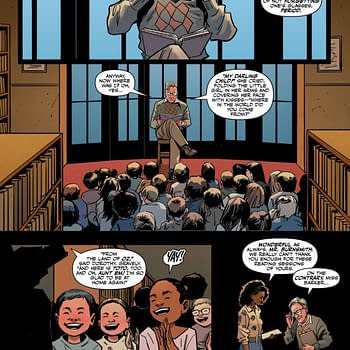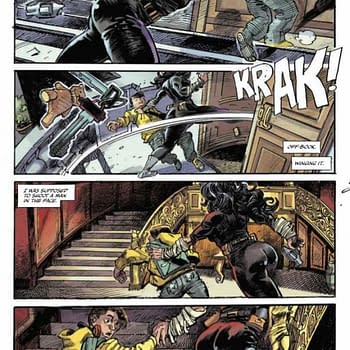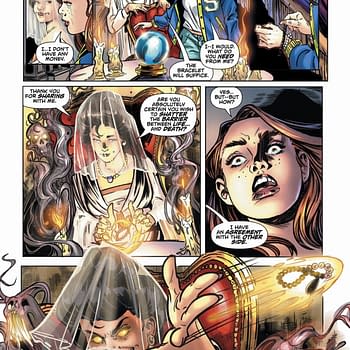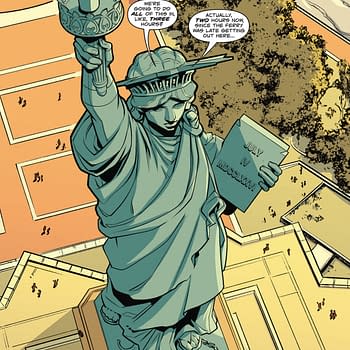Posted in: Comics, Recent Updates | Tagged: dc comics, Dick Sprang, doug moench, Graphitti Designs, kelley jones, Marshall Rogers, The Kelley Jones Batman Gallery Edition
Ahead Of His Gallery Edition Release, Talking With Kelley Jones About Batman And His Career In Comics
By Nikolai Fomich
For many Batman fans who grew up reading comics in the nineties, the haunting visuals of Kelley Jones were a freshly imaginative and enjoyably macabre pleasure, his expressionistic and surreal illustration invigorating the books he penciled with a charge of gothic horror. Like the vital lightning which energized the bizarre machinery of Dr. Frankenstein and gave his creature life, Kelley's artwork enlivened the chilling Batman stories of Doug Moench with a zeal that made good stories great. This month Jones fans will be able to rediscover those classic stories in a whole new way, with the release of The Kelley Jones Batman Gallery Edition from DC Comics and Graphitti Designs. I spoke with Kelley about his career in comics, his work on Batman, and the new Gallery Edition.
Nikolai Fomich: Kelley, let's start from the beginning – what were some of your favorite comics growing up? Who were some of your favorite artists? I remember reading the letters page from an issue of Batman where Doug Moench mentions that Dick Sprang was your favorite Batman artist.
Kelley Jones: Some of my favorite comics growing up were reprint books, in particular Marvel's Greatest Comics and Marvel Collectors' Item Classics. I was so happy to get all these great stories with the F.F., Hulk, Thor and the like. My love for first run stories were comics like Tales to Astonish, Tales of Suspense and Journey into Mystery, and that was because you got two stories in each issue. That was so exciting to me!
Dick Sprang was just the personification of a page turning comic artist to me, you never knew what he would do next. My all-time favorite though was Marshall Rogers. I became mesmerized by his pitch perfect version of Batman. His striking Batman cape swirling, his definitive rogues gallery, and mysterious Gotham City, all came together like few others before or since. And his Joker…whew!
NF: Why did you decide to become a comic book artist? Other than the fact that it's one of the few jobs where you can listen to a ball game without getting in trouble?
KJ: I fell into being a comic artist. I thought I was going into a career in history or archeology. I was going to school when I was given the opportunity to ink for Marvel.
NF: One of your first major gigs in comics was Micronauts, back in the mid-eighties. How did you break into the industry and land that job at Marvel?
KJ: I sent my art samples to both Marvel and DC, and coincidentally received responses several months later on the same day. Marvel said they would like to hire me as an inker, and DC said thanks but no thanks. Both companies cited the same reasons for their decision. I still have those letters somewhere, and regret I never got Dick Giordano to autograph his. We had a big laugh when I told him that about his rejection letter when he asked how I got into comics. He was a big help in my career – I loved how he laid out his studio, and copied it when I got home.
The Micronauts was offered to me after Jackson Guice quit the title. I never thought of myself as a penciller, and only drew pages so I could ink something to show in my samples to Marvel. Ralph Macchio said that though he looked into hiring other artists for the book, he kept coming back to my pencils. I told him I really hadn't drawn on the level he was asking of me. Ralph said not to worry, and he would walk me through it…I learned a lot from him and Bob Harras, his assistant then. I was lucky because Peter Gillis, the writer on the Micros [at the time], really let me go into all kinds of odd directions and played it up. It was a great training ground.
NF: Moving into the nineties, your career took off when you began illustrating arcs on Neil Gaiman's Sandman series and various Bat-titles. During this time your art style matured into the expressionistic and exaggerated gothic horror illustration you are known for.
I know when I read comics growing up you were one of the first artists whose style I began to instantaneously recognize. And in some ways, I can see the influence of Dick Sprang in your work – in the cartoon surrealism and detail-oriented panoramas. Looking back, how did you mature as an artist during this period and develop your distinctive style?
KJ: When I came over to DC, I was asked to draw Deadman. On Deadman I decided to try a more "cinema-style" of storytelling. That approach led to some more surreal and symbolic touches that a horror story lends itself well to. When that was a success, I kept [using] that style of storytelling when I went on to Sandman, Aliens and Batman: Red Rain.
NF: After the Knightfall trilogy, you moved from illustrating Batman miniseries and covers to the main Batman book itself, where Doug Moench wrote the weirdest and best stories of his career – macabre tales which were a perfect fit for your artwork. What was working with Doug, inker John Beatty, and the rest of your team like?
KJ: You describe it as a team, and it was in every sense. I loved Doug's scripts and John Beatty's inking. I was a big fan of both and followed their careers as a fan. I told Doug that I had a box of comics labeled "'good stuff' Books" [that] I kept out of storage because I liked rereading them. Easily three quarters of the books were comics he had written. That was intimidating when I realized that! He laughed pretty hard, and then winked and said how come they weren't all his comics!?
John Beatty inking me was a very big deal. A few years prior, when I was a nobody, Big John called me and said he would like a chance to work together if the chance came up. You have to remember that John Beatty was one of the top three or four inkers in the business, so I was floating on air after that call. Denny O'Neil let us do our thing, and it really clicked from the start. Greg Wright colored it with great skill and power. He brought out all the art beautifully and I remember feeling very safe with him there. Todd Klein lettered it, and did so in the way that was unique to Batman – at least that's how it looked to me. Doug and I liked it so much we thought of more sound effects and odd titles for him to do. It added an intangible to the stories.
It was the best time of my life with those guys. We had a real esprit de corps, and each part did make a greater whole. The books have more than held up – they seem better now than I remember, and that is due to it being such a collaborative effort.

NF: Any particular favorite moments or issues from the run? Who or what did you enjoy illustrating the most?
KJ: That's hard to say. My favorite things were surprises that came up unexpectedly. Stuff like designing the Bat-Signal, and his different devices, and of course his fifties-fashioned Formula One Batmobile. I loved all of it.
NF: One of the coolest aspects of your artwork on Batman was that old-fashioned Universal Horror style equipment and machinery you drew. Stories like The Ogre and the Ape paid tribute to those movies and some of the equipment in the Batcave looks like it came straight out of the 1931 Frankenstein film! How much of an influence did the Universal Horror films have on you and Doug?
KJ: I can't speak for Doug, but James Whale is a huge influence on me. I loved Kenneth Strickfaden's machines designed for the monster's creation. They made no sense and were perfect for Batman. Universal had an atmosphere to their films in the thirties and I wanted to create something similar during my run in the nineties.
NF: By the way, I've always wondered who that mysterious puppeteer was that would show up every so often, though Batman never saw him. Was that just a visual quirk you put in for fun or was it a part of a larger story you and Doug were leading up to?
KJ: There was a story. The Puppeteer's presence was something that was to be told in our ill-fated fourth year.
NF: Maybe you and Doug will be able to tell that story someday! Moving into the present, DC Comics and Graphitti Designs are launching their new Gallery Edition series by releasing the first ten issues of your Batman run in an oversized black-and-white volume this month, with the art in the book reproduced directly from the original artwork. What can fans expect from the Kelley Jones Batman Gallery Edition? What makes this book special?
KJ: What will be striking to me is the level of detail John and I achieved. Our enthusiasm is all over the place. The stuff in black and white will be a brand new experience to even readers who know these stories intimately. Bob Chapman at Graphitti Designs oversaw the reproduction to a level where the art looks exactly as the originals did. All the decisions and corrections and flourishes are seen with no distortions. It's a wonder to be sure. There are other little surprises as well, but I'll let those who get one discover for themselves and not spoil it.

NF: Finally, recent years have seen you illustrate stories for Dark Horse like The 13th Son (which you also wrote), The Crusades for Image, and more Batman. I was pleasantly surprised to see your art in a back-up story in a recent issue of Batman. Any plans for the future that you can talk about, at DC or elsewhere? Where can Jones enthusiasts expect to find your work next?
KJ: I have a miniseries with Swamp Thing coming out soon, then a Batman miniseries with the Scarecrow. [And] after that, something else with Batman, but of that I cannot speak…
[Swamp Thing preview, via Nerdist.com]
Many thanks to Kelley Jones for taking the time to chat about his career in comics. Be sure to check out his Swamp Thing miniseries next year, written by Len Wein himself!
Nikolai Fomich is a writer and writing teacher in the Philadelphia area. Follow him on Twitter @brokenquiver























